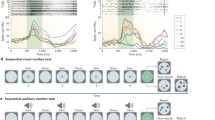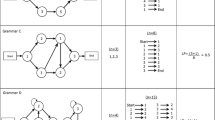Abstract
We trained two monkeys to draw copies of geometrical shapes (e.g. squares, triangles) using a joystick, and found that several variables describing the arm trajectories were encoded in the activity of individual prefrontal neurons (Averbeck et al. 2003). Copy trajectories were drawn as sequences of segments, identified by the serial order in which they were drawn and the shape that they together produced. Here we use linear discriminant analysis to test how well the segments of copied shapes could be decoded from the neural activity patterns of small ensembles (3–22 neurons) of simultaneously recorded cells in prefrontal cortex. Using this analysis, the proper segment (drawn by the monkey) was correctly decoded from the ensemble activity pattern during the drawing of that segment in 60–80% of the cases when the largest ensembles were considered. The information transmitted by these ensembles, as well as by single neurons, was also calculated. We found that the information transmitted by the ensembles increased on average with the number of neurons they contained. Each neuron conveyed information about multiple segments within the drawing trajectory, suggesting that neurons were 'broadly tuned' across segments and that the neural code of segment was distributed.








Similar content being viewed by others
References
Abramson N (1963) Information theory and coding. McGraw-Hill, New York
Amirikian B, Georgopoulos AP (2000) Directional tuning profiles of motor cortical cells. Neurosci Res 36:73–79
Atick JJ, Redlich AN (1990) Towards a theory of early visual processing. Neural Comput 2:308–320
Atick JJ, Li Z, Redlich AN (1992) Understanding retinal color coding from first principles. Neural Comput 4:559–572
Averbeck BB, Chafee MV, Crowe DA, Georgopoulos AP (2003) Neural activity in prefrontal cortex during copying geometrical shapes. I. Single cells encode metric, sequence and shape parameters. Exp Brain Res (in press)
Barlow HB (1972) Single units and sensation: a neuron doctrine for perceptual psychology? Perception 1:371–394
Benton AL (1968) Differential behavioral effects in frontal lobe disease. Neuropsychologia 6:53–60
Bishop CM (1995) Neural networks for pattern recognition. Oxford University Press, Oxford
Brunel N, Nadal JP (1998) Mutual information, Fisher information, and population coding. Neural Comput 10:1731–1757
Constantinidis C, Franowicz MN, Goldman-Rakic PS (2001) Coding specificity in cortical microcircuits: a multiple-electrode analysis of primate prefrontal cortex. J Neurosci 21:3646–3655
Duda RO, Hart PE, Stork DG (2001) Pattern classification. John Wiley, New York
Foldiak P, Young MP (1995) Sparse coding in the primate cortex. In: Arbib MA (ed) The handbook of brain theory and neural networks. MIT Press, Cambridge MA, pp 895–898
Gainotti G (1985) Constructional apraxia. In: Frederiks JAM (ed) Handbook of clinical neurology, vol 1. Elsevier, Amsterdam, pp 491–506
Gawne TJ, Richmond BJ (1993) How independent are the messages carried by adjacent inferior temporal cortical neurons? J Neurosci 13:2758–2771
Gawne TJ, Kjaer TW, Hertz JA, Richmond BJ (1996) Adjacent visual cortical complex cells share about 20% of their stimulus-related information. Cereb Cortex 6:482–489
Georgopoulos AP, Massey JT (1988) Cognitive spatial-motor processes. 2. Information transmitted by the direction of two-dimensional arm movements and by neuronal populations in primate motor cortex and area 5. Exp Brain Res 69:315–326
Gochin PM, Colombo M, Dorfman GA, Gerstein GL, Gross CG (1994) Neural ensemble coding in inferior temporal cortex. J Neurophys 71:2325–2337
Golomb D, Hertz J, Panzeri S, Treves A, Richmond B (1997) How well can we estimate the information carried in neuronal responses from limited samples? Neural Comput 9:649–665
Gross CG, Rocha-Miranda CE, Bender DB (1972) Visual properties of neurons in inferotemporal cortex of the Macaque. J Neurophys 35:96–111
Hinton GE, McClelland JL, Rumehlart DE (1986) Distributed representations. In: Rumelhart DE, McClelland JL (eds) Parallel distributed processing: explorations in the microstructure of cognition. Vol 1. Foundations. MIT Press, Cambridge MA
Johnson RA, Wichern DW (1998) Applied multivariate statistical analysis. Prentice Hall, Saddle River NJ
Koski L, Iacoboni M, Mazziotta JC (2002) Deconstructing apraxia: understanding disorders of intentional movement after stroke. Curr Opin Neurol 15:71–77
Luria AR, Tsvetkova LS (1964) The programming of constructive ability in local brain injuries. Neuropsychologia 2:95–107
McAdams CJ, Maunsell JH (1999) Effects of attention on the reliability of individual neurons in monkey visual cortex. Neuron 23:765–773
McClurkin JW, Optican LM, Richmond BJ, Gawne TJ (1991) Concurrent processing and complexity of temporally encoded neuronal messages in visual perception. Science 253:675–677
Miller GA (1956) The magical number seven, plus or minus two: some limits on our capacity for processing information. Psychol Rev 63:81–97
O Scalaidhe SP, Wilson FA, Goldman-Rakic PS (1999) Face-selective neurons during passive viewing and working memory performance of rhesus monkeys: evidence for intrinsic specialization of neuronal coding. Cereb Cortex 9:459–475
Optican LM, Richmond BJ (1987) Temporal encoding of two-dimensional patterns by single units in primate inferior temporal cortex. III. Information theoretic analysis. J Neurophysiol 57:162–178
Optican LM, Gawne TJ, Richmond BJ, Joseph PJ (1991) Unbiased measures of transmitted information and channel capacity from multivariate neuronal data. Biol Cybern 65:305–310
Panzeri S, Treves A (1996) Analytical estimates of limited sampling biases in different information measures. Network 7:87–107
Panzeri S, Schultz SR, Treves A, Rolls ET (1999) Correlations and the encoding of information in the nervous system. Proc R Soc Lond B Biol Sci 266:1001–1012
Pouget A, Deneve S, Ducom JC, Latham PE (1999) Narrow versus wide tuning curves: what's best for a population code? Neural Comput 11:85–90
Rao SG, Williams GV, Goldman-Rakic PS (1999) Isodirectional tuning of adjacent interneurons and pyramidal cells during working memory: evidence for microcolumnar organization in PFC. J Neurophysiol 81:1903–1916
Reinagel P, Reid RC (2000) Temporal coding of visual information in the thalamus. J Neurosci 20:5392–5400
Rolls ET, Tovee MJ (1995) Sparseness of the neuronal representation of stimuli in the primate temporal visual cortex. J Neurophysiol 73:713–726
Rolls ET, Treves A, Tovee MJ (1997) The representational capacity of the distributed encoding of information provided by populations of neurons in primate temporal visual cortex. Exp Brain Res 114:149–162
Schoups A, Vogels R, Qian N, Orban G (2001) Practising orientation identification improves orientation coding in V1 neurons. Nature 412:549–553
Shannon CE (1948) A mathematical theory of communication. Bell System Technical Journal 27:379–423, 623–656
Thorpe S (1995) Localized versus distributed representations. In: Arbib MA (ed) The handbook of brain theory and neural networks. MIT Press, Cambridge, MA, pp 549–552
Treves A, Panzeri S (1995) The upward bias in measures of information derived from limited data samples. Neural Comput 7:399–407
Vinje WE, Gallant JL (2000) Sparse coding and decorrelation in primary visual cortex during natural vision. Science 287:1273–1276
Werner G, Mountcastle VB (1965) Neural activity in mechanoreceptive cutaneous afferents: stimulus-response relations, Weber functions, and information transmission. J. Neurophysiology 28:359–397
Williams GV, Goldman-Rakic PS (1995) Modulation of memory fields by dopamine D1 receptors in prefrontal cortex. Nature 376:572–575
Williams GV, Rao SG, Goldman-Rakic PS (2002) The physiological role of 5-HT2A receptors in working memory. J Neurosci 22:2843–2854
Zohary E, Shadlen MN, Newsome WT (1994) Correlated neuronal discharge rate and its implications for psychophysical performance. Nature 370:140–143
Acknowledgements
We would like to thank Stefano Panzeri for providing the algorithm that computed the Bayesian form of the information correction term. This work was supported by United States Public Health Service grant NS17413, the United States Department of Veterans Affairs, and the American Legion Brain Sciences Chair.
Author information
Authors and Affiliations
Corresponding author
Rights and permissions
About this article
Cite this article
Averbeck, B.B., Crowe, D.A., Chafee, M.V. et al. Neural activity in prefrontal cortex during copying geometrical shapes. Exp Brain Res 150, 142–153 (2003). https://doi.org/10.1007/s00221-003-1417-5
Received:
Accepted:
Published:
Issue Date:
DOI: https://doi.org/10.1007/s00221-003-1417-5




